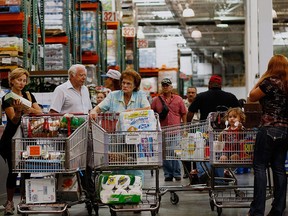Kevin Carmichael: Inflation is a worry, but it’s too soon to panic. We’ve been here before
Article content
FP Economy editor Kevin Carmichael unpacks the week in economics.
Advertisement
This advertisement has not loaded yet, but your article continues below.
Article content
Price surge
Journalists have access to time machines. When we want to take you back, we remind you of what you were listening to during a period of time. Cheap, but effective. So, here we go: Remember The Ketchup Song by Las Ketchup? We didn’t, but Wikipedia claims that was the biggest song in Canada the last time inflation was as hot as it was in August.
New evidence of the surging cost of living flared on the campaign trail, but leaders, who must know that there is very little they can do about inflation in the short term, soon got back to simpler attacks. Statistics Canada’s consumer price index (CPI) is now increasing at an annual rate of four per cent, and the Bank of Canada’s inflation target is two per cent, so we’re in risky territory. Still, Governor Tiff Macklem was ready for it: the central bank’s latest forecast predicted the CPI would average 3.9 per cent in the third quarter. The central bank wouldn’t have panicked.
Advertisement
This advertisement has not loaded yet, but your article continues below.
Article content
Prices still are being manipulated by weird pandemic effects. The latest number was influenced by gasoline, which rose more than 32 per cent from August 2020, when fuel costs were depressed by the COVID-19 recession. Gains of that size won’t continue. Bay Street economist David Rosenberg observed last week that supply has caught up to demand for most commodities, and as a result the price of raw materials now represents a disinflationary force. “As they say, the best cure for high prices is high prices,” Rosenberg wrote with his colleague, Marius Jongstra.
March 2003 marked the end of a four-month stretch of inflation readings above four per cent. (It also was the peak of Las Ketchup’s fame in North America.) The year-over-year increase in the CPI dropped to 2.9 per cent the following month. Inflation is a concern, but it’s too soon to panic. We’ve been here before.
Advertisement
This advertisement has not loaded yet, but your article continues below.
Article content

Home truths
The Conservatives want you to think about post-pandemic price dynamics as “Justin Trudeau’s inflation.” There’s something to that. The main driver of inflation is a mismatch between supply and demand. Trudeau and almost every other leader of a rich country deployed unprecedented levels of stimulus after they shut their economies to arrest the spread of COVID-19. But lots of companies neglected to update their recession playbooks to account for the possibility that governments were prepared to underwrite short-term demand. Households were flush with cash, yet producers had retrenched in anticipation of a disaster. Supply still hasn’t caught up, creating scarcity. You don’t need to be an economist to know what that means.
Advertisement
This advertisement has not loaded yet, but your article continues below.
Article content
By blaming Trudeau for this summer’s inflation burst, you are saying that you think his COVID-19 rescue was too generous, as it left households with too much money to chase too few goods. It also means you would have preferred the natural outcome of a recession that aggressive fiscal stimulus avoided: an extended period of disinflation, and potentially deflation. Pick your poison. Most mainstream economists think the United States, Germany, Canada, and others were too quick to flip to austerity after the Great Recession. The rich world chose to do things differently this time.
The cost of living usually is cheaper than we think. We get hung up on the price of the goods and services we purchase often, rather than the full basket of our needs and wants. Headlines and chatter also are influential. Therefore, even though very few of us are buying houses on a regular basis, our conception of inflation still is influenced by real-estate prices. We’re obsessed. That’s why when the National Post wrote about how the August CPI numbers were playing on the campaign trail, it focused on the sub-index that measures what it would cost homeowners to replicate their current circumstances. The homeowners replacement cost index surged 14 per cent from August 2020, the most since the late 1980s.
Advertisement
This advertisement has not loaded yet, but your article continues below.
Article content
And yet the overall cost of owning a home is growing at about the same rate as it was in 2008 (chart below). That’s because mortgage deflation is almost perfectly offsetting price inflation. Perhaps the one thing the new government could do in the short term to cool inflation would be to release some pressure from the housing market. They could do that by using their regulatory power to make it harder to take out a mortgage. Take a look at the black line in the chart below. Those points where it dips are when the federal government tightened housing policy. But none of the parties are talking about doing that. In fact, the Liberals, the Conservatives, and the New Democratic Party all would make it easier to take out a mortgage.
Advertisement
This advertisement has not loaded yet, but your article continues below.
Article content
“Giving people more money (more borrowing) will increase demand and prices,” former Canada Mortgage and Housing Corp. head Evan Siddall tweeted on Sept. 11. “It may be good politics but it’s irresponsible policy.”

Waiting on wages
We’ll know we’re in an inflationary spiral if wages become unmoored. Anecdotal evidence leaves little doubt that paychecks are rising. But it’s difficult to get a read on whether those increases are problematic. The bigger concern ahead of the COVID-19 crisis was how workers’ share of gross domestic product had been in a long decline, so a raise for the working class is probably overdue. Setting that aside, the data aren’t sending a clear signal. Those who worked throughout the recession tended to be higher paid, making standard year-over-year comparisons unreliable.
Advertisement
This advertisement has not loaded yet, but your article continues below.
Article content
We’ve tried to correct for pandemic effects by watching the wages of workers in industries that worked through the lockdowns, and comparing their current pay with what they were earning two years earlier. As of June, the most recent data available, there still was little evidence that wages were spinning out of control.
Conclusion: Inflation is a threat, but not yet a present danger.

Advertisement
This advertisement has not loaded yet, but your article continues below.
Postmortem: ‘The best cure for high prices is high prices’
2021-09-20 12:15:34






